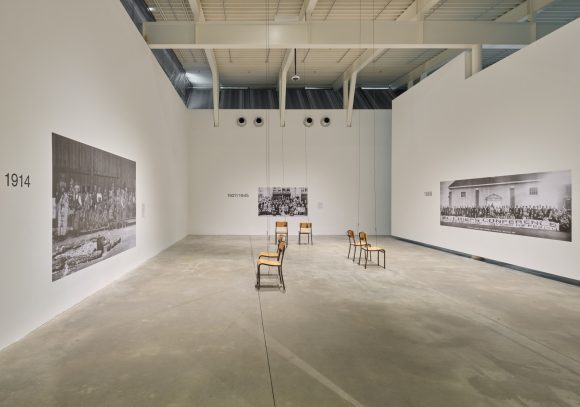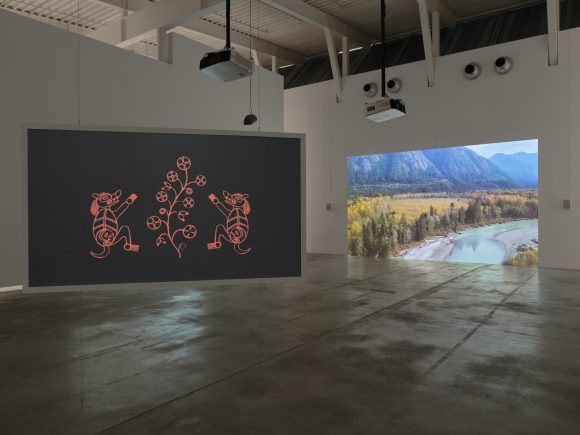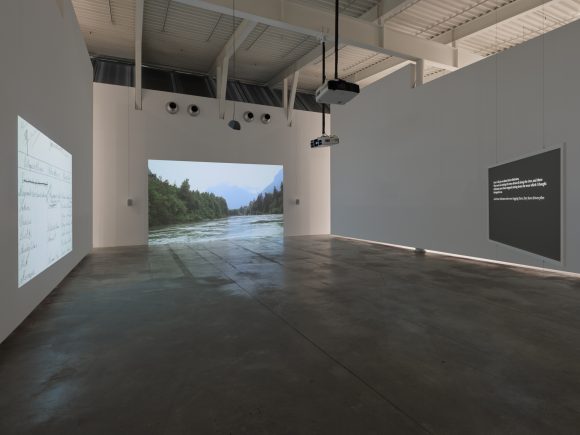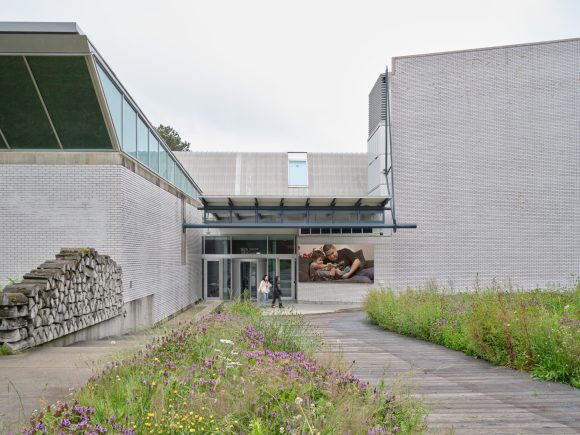21 Jun 2024 – 11 Aug 2024
This Is An Emergency Broadcast
-
Marianne Nicolson
Marianne Nicolson (Kwakwa̱ka̱’wakw, Musga̱maḵw Dzawada̱’enux̱w First Nations, b. 1969) is an artist and activist of the Musga̱maḵw Dzawada̱’enux̱w Nations who are part of the Kwakwa̱ka̱’wakw (Kwak’wala speaking peoples) of the Northwest Coast. She is trained in both traditional Kwakwa̱ka̱’wakw forms and culture and contemporary gallery and museum-based practice. Her practice is multi-disciplinary, encompassing photography, painting, carving, video, installation, monumental public art, writing and speaking. She works as a Kwakwaka’wakw cultural researcher and historian, as well as an advocate for Indigenous land rights. She holds a BFA from the Emily Carr University of Art and Design (1996), an MFA (2000), MA in Linguistics and Anthropology (2005) and PhD in Linguistics and Anthropology with a focus on space as expressed in the Kwak’wala language (2013) all from the University of Victoria. Solo exhibitions include the Art Gallery of Greater Victoria (2008); Artspeak, Vancouver (2006); Esquimalt Municipal Hall (2004); Thunder Bay Art Gallery (2002); National Indian Art Centre, Hull (2001); Campbell River Public Art Gallery (2000) and Or Gallery, Vancouver (1992). Group exhibitions include the 17th Biennale of Sydney (2020); the Morris and Helen Belkin Art Gallery, Vancouver (2020); the Vancouver Art Gallery (2019-20); the National Gallery of Canada, Ottawa (2018-19) and the National Museum of the American Indian, New York (2017-19), among others. Major monumental public artworks are situated in her home territory of the Musga̱maḵw Dzawada̱’enux̱w First Nation, Vancouver International Airport, the Canadian Embassy in Amman, Jordan and the Canadian Embassy in Paris, France.
Following Nicolson’s Hexsa’a̱m: To Be Here Always, a 2019 project with the Belkin that functioned as research, material, media, testimony and ceremony to challenge the western concept that the power of art as limited to the symbolic, This Is An Emergency Broadcast (2023) is another moment to amplify Indigenous tradition.
Read More
-
Melanie O’Brian
CuratorMelanie O’Brian is Associate Director/Curator at the Belkin, and has been the gallery’s Acting Director/Curator 2022 to the present. Prior to joining the Belkin, O’Brian was Director/Curator of Simon Fraser University Art Galleries, including Audain, Teck and SFU Gallery, from 2012 to 2020. She was formerly Curator/Head of Programs at The Power Plant Contemporary Art Gallery in Toronto, Director/Curator at Artspeak in Vancouver and Assistant Curator at the Vancouver Art Gallery. O’Brian has taught at UBC, Emily Carr University and Simon Fraser University, and received her MA in Art History from the University of Chicago. She has organized exhibitions locally and internationally, edited numerous publications and written extensively for catalogues and magazines.
Read More
Please note that the gallery will be closed for a gathering on Sunday, 11 August 2024
The radio is a tool. Through receptive listening and attention there is potential for the creation of a community of receivers. In the act of transmission, there is agency and responsibility that is at once collective and individual, that works with echoes, waves, reverberations, repetitions, cycles, and is only meaningful when received. This Is An Emergency Broadcast connects Indigenous political advocacy with the forms of communication offered by community radio, countering power chronicles of state and corporate media and, in its self-determination, offering space for reignited narratives.
A project with artist and activist Marianne Nicolson (Musga̱maḵw Dzawada̱’enux̱w), This Is An Emergency Broadcast occupies the Belkin space with audio recordings that clarify a history of Indigenous articulation, collective organization and opposition to colonial forces. By playing these audio recordings in the gallery – as they will be played on community radio – they are reified for audiences inside and outside remote communities. The recordings are contextualized by archival images and a reading room provides visual, audio and text sources that connect specific histories to the colonial project more widely and to a history of radio in art. In addition, Nicolson’s 2018 video installation work Hexsa’a̱m (To be there always) (with Althea Thauberger) will be installed in the gallery. Aligning with Nicolson’s concept of Ne’nakw – or coming home – the message of protecting community connection, the exhibition seeks to articulate the state of emergency which Indigenous land advocacy foretold in their critique of colonial oppression from the 1914 McKenna McBride land testimony through to today.
The medium of radio is important and vital to Indigenous communities, and is part of a larger project anchored to Ne’nakw, in which Nicolson considers the implications and meaning behind Indigenous community radio in both the set up and programming of CKYO 91.1 FM Gwa’yi Radio and other community-based Indigenous community radio stations. Through Ne’nakw, Nicolson asked that the Belkin work with her over a period of time to ask how we can support Indigenous practices in a non-extractive way. Through a process of decolonial exploration, the goal is to return cultural capacity to community through art as a form of repatriation and restitution. Tangible physical objects have a concreteness in terms of repatriation, but how can cultural returns be approached? In struggling with the intangible, radio can be a tool to share culture in and across community.
Radio has been a forum for political discussion, expression and for notification of social and political emergencies. Distinct from social media’s potential for digital social isolation and framed within the historical use of radio broadcast to coordinate and communicate Indigenous land rights, This Is An Emergency Broadcast expresses a voice from past broadcasts into the contemporary emergency of climate change and the rise of totalitarianism.
Download the exhibition brochure.
Listen to Marianne Nicolson discuss the historical photographs.
Marianne Nicolson is an artist who works as a Kwakwa̱ka̱’wakw cultural researcher and historian, as well as an advocate for Indigenous land rights. Her work seeks to uphold a traditional Kwakwa̱ka̱’wakw worldview through contemporary mediums and technology. Following Nicolson’s Hexsa’a̱m: To Be Here Always, a 2019 project with the Belkin that functioned as research, material, media, testimony and ceremony to challenge the western concept that the power of art is limited to the symbolic, This Is An Emergency Broadcast is another moment to amplify Indigenous tradition.






This Is An Emergency Broadcast is made possible with the generous support of the Audain Foundation, the Canada Council for the Arts, the Province of British Columbia through the BC Arts Council and our Belkin Curator’s Forum members.
-
Marianne Nicolson
Marianne Nicolson (Kwakwa̱ka̱’wakw, Musga̱maḵw Dzawada̱’enux̱w First Nations, b. 1969) is an artist and activist of the Musga̱maḵw Dzawada̱’enux̱w Nations who are part of the Kwakwa̱ka̱’wakw (Kwak’wala speaking peoples) of the Northwest Coast. She is trained in both traditional Kwakwa̱ka̱’wakw forms and culture and contemporary gallery and museum-based practice. Her practice is multi-disciplinary, encompassing photography, painting, carving, video, installation, monumental public art, writing and speaking. She works as a Kwakwaka’wakw cultural researcher and historian, as well as an advocate for Indigenous land rights. She holds a BFA from the Emily Carr University of Art and Design (1996), an MFA (2000), MA in Linguistics and Anthropology (2005) and PhD in Linguistics and Anthropology with a focus on space as expressed in the Kwak’wala language (2013) all from the University of Victoria. Solo exhibitions include the Art Gallery of Greater Victoria (2008); Artspeak, Vancouver (2006); Esquimalt Municipal Hall (2004); Thunder Bay Art Gallery (2002); National Indian Art Centre, Hull (2001); Campbell River Public Art Gallery (2000) and Or Gallery, Vancouver (1992). Group exhibitions include the 17th Biennale of Sydney (2020); the Morris and Helen Belkin Art Gallery, Vancouver (2020); the Vancouver Art Gallery (2019-20); the National Gallery of Canada, Ottawa (2018-19) and the National Museum of the American Indian, New York (2017-19), among others. Major monumental public artworks are situated in her home territory of the Musga̱maḵw Dzawada̱’enux̱w First Nation, Vancouver International Airport, the Canadian Embassy in Amman, Jordan and the Canadian Embassy in Paris, France.
Following Nicolson’s Hexsa’a̱m: To Be Here Always, a 2019 project with the Belkin that functioned as research, material, media, testimony and ceremony to challenge the western concept that the power of art as limited to the symbolic, This Is An Emergency Broadcast (2023) is another moment to amplify Indigenous tradition.
Read More
-
Melanie O’Brian
CuratorMelanie O’Brian is Associate Director/Curator at the Belkin, and has been the gallery’s Acting Director/Curator 2022 to the present. Prior to joining the Belkin, O’Brian was Director/Curator of Simon Fraser University Art Galleries, including Audain, Teck and SFU Gallery, from 2012 to 2020. She was formerly Curator/Head of Programs at The Power Plant Contemporary Art Gallery in Toronto, Director/Curator at Artspeak in Vancouver and Assistant Curator at the Vancouver Art Gallery. O’Brian has taught at UBC, Emily Carr University and Simon Fraser University, and received her MA in Art History from the University of Chicago. She has organized exhibitions locally and internationally, edited numerous publications and written extensively for catalogues and magazines.
Read More
Related
-
Event
Saturday, 10 Aug 2024 at 2 pm
Conversation: Marianne Nicolson and Gord Hill

Join us for a conversation between artist and activist Marianne Nicolson (Kwakwaka’wakw, Musgamakw Dzawada’enuxw) and artist Gord Hill (Kwakwa̱ka̱’wakw) on the current exhibition, This Is An Emergency Broadcast.
[more] -
Exhibition
21 Jun – 11 Aug 2024
Outdoor Screen: Nuxalk Radio

As part of the exhibition This Is An Emergency Broadcast, Banchi Hanuse's Nuxalk Radio (2021) plays on the Outdoor Screen from 9 am to 9 pm daily.
[more] -
Event
Saturday, 22 Jun 2024 at 2 pm
Listening Event with Lorna Brown

Artist Lorna Brown will lead a collective listening experience in This Is An Emergency Broadcast, offering an opportunity for witnessing in a context of advocacy and oral tradition.
[more] -
News
19 Jun 2024
Reading Room: This Is An Emergency Broadcast

This Is An Emergency Broadcast connects Indigenous political advocacy with the forms of communication offered by community radio, countering power chronicles of state and corporate media and, in its self-determination, offering space for reignited narratives. A project with artist and activist Marianne Nicolson (Musga̱maḵw Dzawada̱’enux̱w), This Is An Emergency Broadcast occupies the Belkin space with audio recordings that clarify a history of Indigenous articulation, collective organization and opposition to colonial forces.
[more] -
Exhibition
11 January 2019 – 7 April 2019
Hexsa’a̱m: To Be Here Always

Working together at Kingcome Inlet in Summer 2018, a group of artists used film, video, social media, weaving, animation, drawing, language and song to address the urgent threats to the land and water. A manifestation of the relationships formed between the participants over this past year, Hexsa’a̱m: To Be Here Always is based on sharing knowledge and respectful collaboration. Simultaneously research, material, media, testimony and ceremony, the exhibit challenges the western concept that the power of art and culture are limited to the symbolic or metaphoric, and that the practices of First Peoples are simply part of a past heritage. As Marianne Nicolson states, “We must not seek to erase the influence of globalizing Western culture, but master its forces selectively, as part of a wider Canadian and global community, for the health of the land and the cultures it supports. The embodied practice of ceremonial knowledge relates to artistic experience – not in the aesthetic sense, but in the performative: through gestures that consolidate and enhance knowledge for positive change.” Hexsa’a̱m: To Be Here Always positions the gallery as an active location for this performance, drawing together many faculties and disciplines of the university in generative exchange.
[more] -
Event
Critical Image Forum Dialogue Series: Marianne Nicolson

As part of Critical Image Forum's Dialogue Series, this online conversation with Althea Thauberger, Musgamakw Dzawada’enuxw artist and activist Marianne Nicolson helps us understand how particular photographic acts, although initiated by Canadian colonial photographers, were used, by those depicted, as opportunities for assertions of political, cultural and territorial sovereignty during the potlatch ban in the early twentieth century.
[more] -
Event
25 Mar 2017, 1 pm
Artist Talk: Marianne Nicolson
Join artist Marianne Nicolson who will talk about two works in the exhibition To refuse/To wait/To sleep, Tunics of the Changing Tide (2007) in the Walter C. Koerner Library and The Sun is Setting on the British Empire (2016) on the facade of the Belkin Art Gallery. Watch the talk online.
[more]